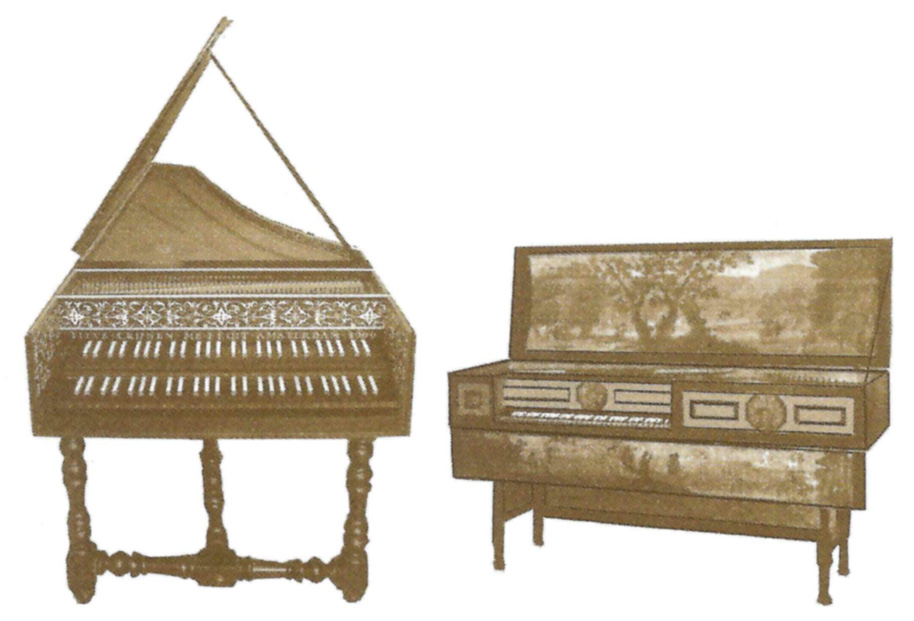Keyboard Music by John Bull
with Kathryn Cok
Media Review / Listening Diary 2014-08-24
2014-08-24 — Original posting (on Blogger)
2014-11-13 — Re-posting as is (WordPress)
2016-07-23 — Brushed up for better readability
Table of Contents
Introduction
My first encounter with Kathryn Cok was through sonatas for horn and piano by Beethoven, Krufft and Leidesdorf. This was in a recording with Anneke Scott playing the natural horn, and Kathryn Scott very aptly playing the accompaniment on a fortepiano. For details see the Listening Diary 2013-09-30. I really liked Kathryn Cok’s performance on the fortepiano and therefore looked around for other recordings by this artist.
I could not resist acquiring the CD below. Especially as John Bull (1562/3 – 1628) wasn’t present in my CD library at all). That proved rather tricky, though, as the CD appears to be out of stock. After waiting for a couple of months (for Amazon to locate a CD) I resorted to a private Amazon vendor in the U.S. for a pristine copy — and here it is:
John Bull: “Dr. Bull’s Jewel” — Keyboard Music
Kathryn Cok — harpsichord and virginal
The Lyrichord Early Music Series, LEMS 8060 (CD, stereo); ℗ / © 2007
Booklet: 8 pp. English/Dutch

John Bull
In his time, John Bull (1562/3 – 1628) apparently was one of the most famous composers for keyboard music. Only Girolamo Frescobaldi (1583 – 1643) and William Byrd (1540 – 1623) possibly surpassed him. Yet, today he is almost completely absent from concert programs, and we know very little about his life. Even where and when he was born is not known for sure. He spent some time in Oxford and London, but in 1613 he fled from England for obscure reasons. He then spend the rest of his life in Antwerp, where he worked as an organist at Antwerp Cathedral. It appears that much of his music got lost (or possibly stolen by other composers) when he fled England. We do, however, have a fair number of keyboard compositions, as well as vocal works (anthems, canons).
Kathryn Cok
Given that John Bull is not adequately represented in today’s concert programs, Kathryn Cok‘s recording of keyboard music by this composer is most welcome! Kathryn Cok was born in New York, USA, and now lives in Den Haag, Netherlands, where she completed a Master’s degree at the Royal College of Music, studying harpsichord playing with Ton Koopman and Tini Mathot (Koopman’s wife), and fortepiano with Bart van Oort. In 2011, she defended her Ph.D. thesis “Basso Continuo Sources from the Dutch Republic c.1620-c.1790” at the University of Leiden, NL.
The Instruments
On the above CD, Kathryn Cok is playing two different instruments:
- a harpsichord by Titus Crijnen (Amsterdam), after Ioannes Ruckers, 1638
This appears to be a Flemish instrument with two keyboards. - a virginal by Willem Kroesbergen (Utrecht), after Andreas Ruckers, 17th century (collection Ton Koopman)
This is a spinet virginal (as opposed to a muselar virginal). Virginals are small, rectangular harpsichords, with the strings running parallel to the keyboard. Compared to a harpsichord, the strings are plucked closer to the center. This produces a darker (simpler? more archaic?) tone with fewer harmonics.
No further details on the instruments are given, apart from two sketchy photographs:
Tuning
Both instruments feature quarter-comma meantone temperament tuning (see also my blog post “Progress in Tuning?” for an overview). The exact pitch is not specified (I suspect a’ = 415 Hz).
The Repertoire on the CD
Kathryn Cok selected the pieces such as to provide a representative overview over the variation in styles and forms in Bull’s oeuvre for keyboard instruments. Unfortunately, the small booklet (= folded leaflet) is a little unclear about the choice of instruments for a given piece. Kathryn Cok writes: “While the keyboard music of Bull is frequently interpreted on the organ, I have chosen to use the rich, resonant sound of the harpsichord for the more serious and densely harmonic pieces on the CD, and the crisp, light sound of the virginal for the secular settings and variation sets.” To the amateur listener, this is not entirely conclusive (and actually incorrect for the “Walsingham” variations, see below). However, from the sound, one can easily determine the instrument.
Track Listing
Here’s the track listing with the instruments selected:
- Bull’s Goodnight (virginal) — 2’57”
- Chromatic Pavan & Galliard (harpsichord)
- Queen Elizabeth’s Chromatic Pavan — 6’04”
- Chromatic Galliard — 3’40”
- The King’s Hunt (virginal) — 3’28”
- Walsingham (harpsichord) — 17’34”
- Bonny Peg of Ramsey (virginal) — 1’27”
- Fantastic Pavan & Galliard (harpsichord)
- Fantastic Pavan — 5’34”
- Galliard to the Fantastic Pavan — 2’12”
- My Self (virginal) — 2’20”
- In Nomine (harpsichord) — 7’22”
- My Jewel (virginal) — 2’16”
- The Quadran Pavan and Galliard (harpsichord)
- The Quadran Pavan — 7’03”
- Galliard to the Quadran Pavan — 7’00”
Key Pieces: Pavan & Galliard
The biggest portion of the CD is devoted to three pairs of dance movements — the then popular pavan & galliard grouping. At the time of John Bull, the pavan (paven, pavin, pavane, etc.) is a slow dance on an even beat (2/2 or the like). The galliard (gaillarde, etc.) was a popular dance in the 16th century. It features the following rhythmic scheme:
In the pairing pavan + galliard, the latter is the faster dance, definitely with a more intricate rhythm. On this CD, the three pavan & galliard pairs are all played on the harpsichord:
Chromatic Pavan & Galliard
This isn’t quite “chromatic” in our current understanding, nor maybe in the sense of Bach’s famous “Chromatic Fantasy & Fugue” (BWV 903). It does feature some rather unusual harmonic progressions. However, if one were to play these on a modern instrument, they would likely not sound all that unfamiliar.
In my perception, the key feature here is in the exploration of remote tonalities — tonalities which are just about still playable in meantone temperament tuning, which brings me to the (for me) main feature of this recording: if you need a proof that the modern piano is not adequate for playing this music, this is an excellent example! All those beautiful, pure thirds, and on the other hand then distinct colors caused by the varying degree of “dissonant” (“out-of-tune”) fifths — people really should take some time to listen into such recordings / interpretations, it’s just marvelous! Towards the end, the Pavan also features some beautiful melodic inventions.
Fantastic Pavan & Galliard
That’s the shortest of the three pairings; I don’t think the “Fantastic” has anything to do with Buxtehude’s “stylus fantasticus”, even though it does feature a couple rapid ornamentations — very nice music, exposing the marvelous sound of Kathryn Cojk’s early baroque (or pre-baroque) harpsichord (featuring two 8′ stops and one 4′ stop, apparently no lute stop).
The Quadran Pavan and Galliard — and a Comparison with Byrd
This, finally, has an equivalent in the oeuvre of William Byrd (1540 – 1623), in the “Quadran Paven & Galliard” (BK 70) which can be heard on CD #5 of Davitt Moroney‘s recording of Byrd’s complete keyboard works (see below). According to Moroney, the term “quadran” apparently refers to the square-shaped sign used in early notation for the natural B in G major (as opposed to the B♭ in G minor). In the liner notes to the recording below, Moroney writes that Thomas Tomkins (1572 – 1656) included Byrd’s Quadran pair in his first list of Lessons of worthe. Tomkins noted that they were “Excellent For matter”, while he includes Bull’s Quadran, because it is “Excellent For the Hand”. According to Moroney, this indicates that Bull’s virtuosic set is technically brilliant and regarded superior to Byrd’s.
When comparing Byrd’s set with John Bull’s in the two recordings described here, one can at best identify some remote references to Byrd’s composition in John Bull’s work (the pitch is not the same in the two recordings — probably a’ = 415 Hz vs. a’ = 392 Hz — which makes direct comparisons a bit tricky for non-experienced listeners). John Bull’s pair is the longest of the three in Kathryn Cok’s recording — and I find it the nicest and most artful of the three sets, one of the highlights on this CD.
In Nomine
Another, definitive highlight is the In Nomine — one of 12 that John Bull has written. According to Wikipedia, the In Nomine originated in the early 16th century from a six-voice mass composed before 1530 by John Taverner on the plainchant “Gloria Tibi Trinitas”. In the Benedictus section of this mass, the Latin phrase “in nomine Domini” was sung in a reduced, four-part counterpoint, with the plainchant melody in the mean part (…). At an early point, this attractive passage became popular as a short instrumental piece, (…). Over the next 150 years, English composers worked this melody into “In Nomine” pieces of ever greater stylistic range.
Bull’s In Nomine may be the most prominent example of an “In Nomine” for keyboard instruments (as opposed to polyphonic pieces for various instrumental consorts used most often). Another masterwork, harmonically rich, often intricate, exploring the very limits of the playable tonalities in quarter-comma meantone temperament tuning — fascinating!
Walsingham
With a duration of over 17 minutes, the biggest piece on this CD, Walsingham, is almost a monster (Kathryn Cok calls it monumental) — a rich, artful, elaborate set of variations (apparently John Bull’s specialty!), based on a popular melody in the early 16th century. Other composers used that same theme as well. The most well-known predecessor, also a set of variations, probably is William Byrd’s “Have with yow to Walsingame” (BK 8, included on CD #2 of Davitt Moroney‘s recording shown below). Just to put the duration in perspective: within the complete keyboard works of William Byrd, the longest piece, “The Battell” (BK 94, included on CD #7 in the set below) takes close to 13 minutes, the second longest is “Have with yow to Walsingame” with 9.5 minutes.
However, the two compositions are hardly comparable, i.e., they are very different: Bull uses a wide range of variations in harmony, rhythm, and ornamentation; William Byrd’s variations fascinate through its careful “orchestration”, leading to fascinating climaxes with elaborate ornamentation: here, I find Byrd’s composition more impressive, more involving (compared to Bull’s).
Note that in the recording below (also for the “Quadran Paven & Galliard“), Davitt Moroney plays a more recent type of harpsichord, a replica of an instrument by Ioannes Couchet, Antwerp, from 1679 (built by Reinhard von Nagel, Paris) — an instrument with two manuals, 4′ and 2 x 8′ stops, with lute stop, giving a broader range of possibilities, which Davitt Moroney of course explores to full extent in these variations.
John Bull’s “Selfies”
For all remaining pieces, Kathryn Cok plays on a virginal (see above). The instrument is clearly discernible from the harpsichord, through its darker, maybe more “archaic” sound, with fewer harmonics. There is a single 8′ stop, i.e., there is no variability by combining stops or manuals, etc., it therefore makes sense to use this instrument for the shorter pieces only.
Three of these pieces (all 2 – 3 minutes) are little character pieces describing (the composer’s?) characters, states of mind — all, indeed, little jewels (as the title of the third piece below, also referred to in the title of the CD, indicates):
- Bull’s Goodnight
- My Self
- My Jewel
More Hits
Finally, there are two more pieces in Kathryn Cok’s recording:
- The King’s Hunt — this is definitely another highlight in this recording. A fascinating, enthralling piece (an early “hit”, I would say) that in many ways reminds of the various “battle” pieces of the time (such as William Byrd’s “The Battell”, BK 94, included on CD #7 in the set below). This sounds like a heated, if not hectic, hunt, indeed. One can easily picture the king and his people riding on horses, through woods and fields.
- Bonny Peg of Ramsey — compared to “Walsingham”, this is a minuscule — but nevertheless lovely! — set of variations on a popular ground of the time.
Conclusion
This CD is definitely worth a warm recommendation: if you are looking for an entry point into pre-baroque instrumental music (especially keyboard music with pre-baroque tuning) — here it is (if only the CD was more readily available!)!
Addendum
Here’s Davitt Moroney‘s recording with William Byrd’s complete keyboard works on 7 CDs, referred to in the text above — discussing this in more detail is beyond the scope of this note (but nevertheless, it’s a recording that I can definitely recommend as well!):
William Byrd: The Complete Keyboard Music
Davitt Moroney — harpsichord, virginal, chamber organ, clavichord
hyperion CDA66551/7 (7 CDs, stereo); ℗ / © 1999
Booklet: 200 pp. English/French

Listening Diary Posts, Overview








